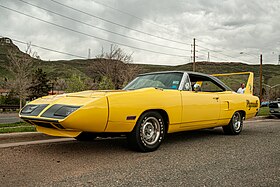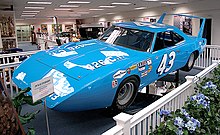Plymouth Superbird
| Plymouth Superbird | |
|---|---|
 | |
| Overview | |
| Manufacturer | Chrysler Corporation |
| Production | 1970 |
| Assembly | Detroit, Michigan (Lynch Road Assembly) |
| Designer | Gary Romberg[1] |
| Body and chassis | |
| Class | muscle car, race car |
| Body style | 2-door coupe |
| Layout | FR layout |
| Platform | B-body |
| Related | Plymouth Road Runner Dodge Charger Daytona |
| Powertrain | |
| Engine | 426 cu in (7.0 L) Hemi V8 440 cu in (7.2 L) Super Commando V8 |
| Transmission | 4-speed manual 3-speed automatic Torqueflite 727 |
| Dimensions | |
| Wheelbase | 115.8 in (2,941 mm)[2] |
| Length | 221 in (5,613 mm)[2] |
| Width | 76.4 in (1,941 mm)[2] |
| Height | 61.4 in (1,560 mm)[2] |
| Curb weight | 3,841 lb (1,742 kg)[3] |

The Plymouth Superbird is a highly modified, short-lived version of the Plymouth Road Runner with applied graphic images as well as a distinctive horn sound both referencing the popular Looney Tunes cartoon character the Road Runner. It was the factory's follow-up stock car racing design, for the 1970 season, to the Dodge Charger Daytona of 1969, and incorporated many engineering changes and modifications (both minor and major) garnered from the Daytona's season in competition.[4]
The car's primary rivals were the Ford Torino Talladega and Mercury Cyclone, a direct response to the Mopar aero car. It has also been speculated that a motivating factor in the production of the car was to lure Richard Petty back to Plymouth.[5] Both of the Mopar aero cars famously featured a protruding, aerodynamic nosecone, a high-mounted rear wing and, unique to the Superbird, a horn mimicking the Road Runner's signature "beep, beep."[6]
Superbirds equipped with the top-of-the-line 426 cu in (7.0 L) Hemi engine with a pair of four barrel Carter AFB carburetors (2x4bbl) producing 425 hp (317 kW) could accelerate from 0 to 60 mph (97 km/h) in 5.5 seconds.[7]
History[edit]
Developed specifically for NASCAR racing, the Superbird, a modified Road Runner, was Plymouth's follow-on design to the Charger Daytona fielded by sister company Dodge in the previous season. The Charger 500 version that began the 1969 season was the first American car to be designed aerodynamically using a wind tunnel and computer analysis, and later was modified into the Daytona version with nose and tail. The Superbird's smoothed-out body and nosecone were further refined from that of the Daytona, and the street version's retractable headlights (made of fiberglass[2]) added nineteen inches to the Road Runner's original length. The rear wing was mounted on tall vertical struts that put it into less disturbed air thus increasing the efficiency of the downdraft that it placed upon the car's rear axle. For nearly 30 years the mathematic formula used to determine the exact height of the enormous wing was thought to be a highly guarded Chrysler secret. In the 1990s, a retired Chrysler project engineer incorrectly[8] claimed publicly that the height was determined in much simpler fashion: he claimed it was designed to provide clearance for the trunk lid to open freely. This is an urban myth. The actual height was set to clear the roofline so it was in clean air.[9] The rear-facing fender scoops were to hide cutouts. On Daytonas, the scoops were actually for ventilating trapped air from the wheel wells in order to reduce under fender air pressure and lift. For standard road going Superbirds the covers or "air extractors" were a cosmetic enhancement.[10][11] Ground clearance was 7.2 inches (18 centimetres).[2]
NASCAR's homologation requirement demanded that vehicles to be raced must be available to the general public and sold through dealerships in specific minimum numbers. For 1970, NASCAR raised the production requirement from 500 examples to one for every two manufacturer's dealers in the United States; in the case of Plymouth, that meant having to build 1,920 Superbirds. Due to increasing emissions regulations, combined with insurance spike for high performance cars and NASCAR's effective ban on the aero cars, 1970 was its only production year.
"Superbird" decals were placed on the outside edges of the spoiler vertical struts featuring a picture of the Road Runner cartoon character holding a racing helmet. A smaller version of the decal appears on the driver's side headlight door. Superbirds had three engine options: the 426 Hemi V8 engine producing 425 bhp (431 PS; 317 kW) at 5000 rpm and 490 lb⋅ft (664 N⋅m) at 4000 rpm of torque, the 440 Super Commando Six Barrel with 3X2-barrel carburetors producing 390 hp (290 kW) and the 375 hp (280 kW) 440 Super Commando with a single 4-barrel carburetor. Only 135 models were fitted with the 426 Hemi. As the 440 was less expensive to produce, the "street" version of the 426 Hemi engine used in competition was homologated by producing the minimum number required.
On the street, the nose cone and wing were very distinctive, but the aerodynamic improvements hardly made a difference there or on the drag strip. In fact, the 1970 Road Runner was actually quicker in the quarter mile and standard acceleration tests due to the increased downforce produced by the Superbird's nose and wing. Only at speeds in excess of 60 mph (97 km/h) did the modifications begin to show any benefit.[12]
Production numbers[edit]
Chrysler memos of September 1969 show that the sales programming staff were preparing to handle 1,920 winged Plymouths for 1970, but published figures say as many as 2,783 were built. The current figure generally accepted is 1,935 SuperBirds built and shipped to United States dealers, with some 34 to 47 allegedly shipped to Canada. The engine option is also questioned, although the most frequently seen numbers report 135 Hemi SuperBirds and 716 440ci. six-barrel editions, with the remainder powered by 440ci. 4bbl. motors. It is believed that over 1,000 Plymouth SuperBirds exist today.[13]
- 1970 Superbird in Petty Blue
- Pop-up headlights raised
- Road Runner decal on the wing
- 440 Cubic Inch Six Barrel Engine
- 426 Hemi V8 engine
- 1970 Superbird Nose cone close-up
NASCAR[edit]

In Autumn 1968, Richard Petty left the Plymouth NASCAR Racing Team for Ford's. Charlie Grey, director of the Ford stock car program, felt that hiring Petty would send the message that "money rules none". However, the Superbird was designed specifically to lure Petty back to Plymouth for the 1970 season. Petty did reasonably well against strong Ford opposition on the NASCAR tracks that year, winning eight races and placing well in many more.
NASCAR's rules implemented for the 1971 season limited the "aero-cars" to an engine displacement of no greater than 305 cu in (5.00 L) or they had to carry much more weight compared to their competitors. While they were still legal to race, the power-to-weight consequences that would come with the smaller engine or the increased weight rendered the cars uncompetitive. This was the start of a trend of rules slowing down NASCAR, because the races were exceeding the technology of tires and safety over 200 mph (320 km/h). Ford, in response, also designed the 1970 Torino King Cobra with an aerodynamic, superbird-style nose, but it was abandoned.[14][15]
Market impact[edit]
The Superbird's styling proved to be extreme for 1970s tastes (many customers preferred the regular Road Runner), and as a consequence, many of the 1,920 examples built[16] sat unsold on the back lots of dealerships as late as 1972. Some were converted into 1970 Road Runners to move them off the sales lot.[17] Some manufacturers produce Superbird conversion kits for 1970 Road Runners and Satellites.[18] Kits are also available for non produced 1971 and 1972 bodies for the Superbird.[citation needed] More recently they have been very steadily rising in price, regularly fetching from US$200,000 to $450,000 however this does vary based on the engine, gearbox and other factory options on the car.[19][20]
The Superbird and the Dodge Charger Daytona were each built for one model year only (1970 and 1969 respectively).
References[edit]
- ^ Pearce, Al (2020-02-04). "Gary Romberg, The Rocket Scientist Behind NASCAR's 1970 Plymouth Superbird, Dies At 85". Autoweek. Retrieved 2023-07-28.
- ^ a b c d e f "Street SuperBird Specifications". Aero Warriors. Retrieved 2011-11-20.
- ^ The Auto Editors of Consumer Guide (2007-01-16). "HowStuffWorks "1970 Plymouth Road Runner Superbird: A Profile of a Muscle Car"". Musclecars.howstuffworks.com. Retrieved 2011-11-20.
- ^ Sessler, Peter C. (2001). Dodge & Plymouth muscle car red book (2nd ed.). Osceola, WI: MBI Pub. Co. p. 134. ISBN 978-0760308011. Retrieved 13 February 2015.
- ^ Chris Woodyard (November 3, 2013). "Is a wacky '70 Plymouth Superbird worth $500,000?". USA TODAY.
- ^ "Plymouth Road Runner Superbird, 1970 Road Runner Superbird | Conceptcarz.com - Pictures, Pricing, Information, Wallpaper, History". Conceptcarz.com. Retrieved 2011-11-20.
- ^ "Classic Car Database - 1970 Superbird Specs, Colors, Facts, History, and Performance". MyClassicGarage. SpeedDigital. Retrieved 26 June 2015.
- ^ Lehto, Steve (27 June 2016). "The Real Reason the Dodge Charger Daytona's Wing Was So Huge". Road and Track Online. Retrieved 27 June 2016.
- ^ Zatz, David. "The Plymouth Superbird and Dodge Charger Daytona". AllPar.com. David Zatz; 2001-2015, Allpar LLC. Retrieved 13 February 2015.
- ^ Mueller, Mike (2009). The complete book of Dodge and Plymouth muscle. Minneapolis: MBI Pub. Co. and Motorbooks. p. 213. ISBN 9780760330791. Retrieved 13 February 2015.
- ^ Mueller, Mike (2004). Essential musclecars. St. Paul, MN: Motorbooks International. p. 122. ISBN 9780760319666. Retrieved 13 February 2015.
- ^ "Aerodynamic Upgrades". Rapid-Racer.com. Rapid-Racer 2015. Retrieved 20 April 2015.
- ^ SUPERCARS: The Story of the Dodge Charger Daytona and Plymouth SuperBird; Frank Moriarty: ISBN 1-57427-043-5, (1995), page 149.
- ^ Florea, Ciprian (7 July 2014). "1970 Ford Torino King Cobra Prototype". TopSpeed.com. TopSpeed. Retrieved 13 February 2015.
- ^ Adolphus, David Traver. "Game Over - 1970 Ford Torino King Cobra, 1970 Mercury Talladega Super Cyclone Spoiler II The nukes that ended the aero wars". Hemmings.com. Feature Article from Hemmings Muscle Machines. Retrieved 13 February 2015.
- ^ Flory, J. "Kelly", Jr. American Cars 1960-1972 (Jefferson, NC: McFarland & Coy, 2004), p.771.
- ^ Holder, Bill; Kunz, Phil (2003). Chrysler muscle: Detroit's mightiest machines. Iola, WI: Krause Publications. p. 37. ISBN 0873496337. Retrieved 13 February 2015.
- ^ Repros, Janak. "1970 Roadrunner Superbird Wing Car Conversion Kit - Superbird Body Parts by Janak Repros". WingedWarriorBodyParts.com. Winged Warrior Body Parts. Retrieved 13 February 2015.
- ^ "RM Auctions".
- ^ "Haggerty Classic Car values".


 French
French Deutsch
Deutsch




